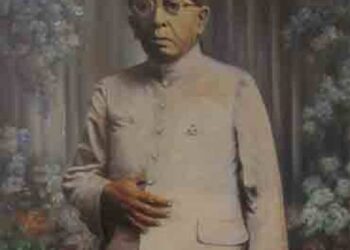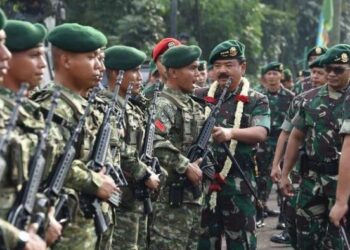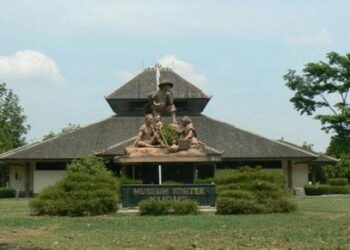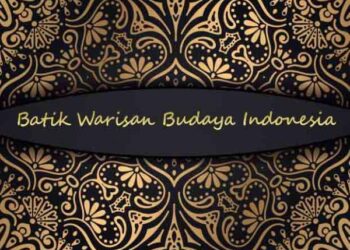Indonesia is a nation that adheres to pluralism and happens to be the fact, that perhaps the most plural in the part of the world. The nation consists of hundreds of ethnic, religious, cultural, and customs, which live in about 13,000 islands both large and small. It speaks in hundreds of regional languages. This multidimensional pluralism has formed Indonesia which is very beautiful and is also very prone to horizontal conflict. The inability to manage pluralism will be able to lead to socio-political chaos (Juhri, 2008:560).

Indonesia as a portrait for a plurality of countries from the viewpoint of religion, ethnic origin, ethnicity, language, and customs, each of which can adapt reasonably to the social environment. Therefore, Indonesia became a beautiful country and rich in social culture. In the case of religion, for example, there are Islam, Christianity, Catholicism, Hinduism, Buddhism, Confucian, and the flow of faith, they can unite the beautiful Indonesian build. Togetherness in diversity is characteristic of the Indonesian revival and also as the mercy of Allah SWT for the Indonesian nation. The issue later, when the provocation arose and incitement to the mass of religion, ethnicity, or certain tribe to the other by the parties who have a certain interest, then togetherness becomes a threat and a threat to the security of the nation as a whole. The diversity we have is the potential of a very frightening conflict for human existence. Therefore the role of the religiously to become the model of their people, so that the moral values of religion are not polluted and the people are not easily provoked by the incitement of the irresponsible parties (Juhri, 2008:561).
Maksum (2011:14) in his multicultural book Conveys Ki Supriyoko (2004) Seeing the diversity and multiculturalism of this nation hinting a variety. This diversity is a very valuable social capital. When used properly it will be a great advantage for the success of this nation. But it is also very vulnerable to conflicts between citizens and between religions while not properly managed. In this context, diversity and multiculturality can be destructive and lead to devastating disasters. Conflicts and social violence that often occur between communities is a part of diversity and multiculturality that cannot be managed properly.
Conflict and social violence are urgent problems amid Indonesia’s cultural reality throughout history. Throughout Indonesia’s pre-independence history to this day, Indonesia’s nation-led life is full of socio-political instability and conflicts that lead to violent acts. Violence in Indonesia as dead as one grows a thousand, stringing perspective first and the viewpoint is now one of the contemporary Indonesian descriptions of violent this is a consequence that the potential of multidisciplinary is not well-managed then it will be a terrible disaster (Maksum, 2011:14).
In other words, it can be saying that the practice of violence has been carried out evenly by each generation in the history of Indonesia’s journey. The reality from religious of ethnic violence has continued to occur in Indonesia, such as the Sambas conflict, Sampit, Maluku, Poso, Ambon, and social turmoil in ACEH and Papua, and many more. It indicates how the construction of multicultural-based nobility in Indonesia (Maksum, 2011:14)
From the explanation above, real violence is a major socio-cultural problem and is important for Indonesians who are solely non-actual but also plundered. The reality nature of violence and social conflict justifies the notion that violence is almost a mind-set of both collective and individual Indonesians. The challenge in the management of multiculturalism and pluralism in Indonesia becomes one of the major responsibilities that are not only borne by religious leaders but by all parties related to it, so that the beauty in multiculturalism can be enjoyed by the Indonesian people who in reality are very diverse.
The lack of multicultural consciousness amid the life of human beings, not merely Indonesian domestic problems, but also global problems. Brenes and Wessells suggest how systematic violence challenges human beings to cultivate a culture of human rights-based peace, equality, freedom, tolerance, solidarity, and protection of Earth resources (Maksum, 2011:15).
On the other, Juhri (2008:557) view religious pluralism or plurality of society can not be understood only with us say that the people of Indonesia is a portrait of a compound society, a heterogeneous society or diverse, with various nationalities, ethnic diversity, religion and the emergence of a different flow of belief, but how to understand pluralism in the context of religious, political and not make the impression that , so that pluralism as a living reality in society is only understood as another form of kindness that is only seen from the point of view of its usefulness to remove the form of narrow fanaticism. Pluralism in the religious context must be understood as a true association of diversity or poverty in social, cultural, or societal bonds. Therefore, the concept of pluralism became a positive factor and meaningful goodness that spread peace and compassion and not as a frightening form, bearing conflict and violence, but a contributing factor to the continuity of human life in Al-Quran QS. Al-Hujurat (49): 13, “Surely we have created you from a man and a woman and made you berbangsa-bangsa and bersuku-suku that ye know each other”. Therefore, pluralism must be viewed on the plus side and not as a disintegrative factor for society (Juhri, 557:2008).
The verse above simply explains that the fact of the creation of man itself in reality is diverse so that the roles and commitments that must be held by religious people who live on plurality like Indonesia is mutual respect and respect for each party in the life of society, between various religious communities that exist and not one religion that impose his belief to people who have been religious. Islam For example, in the book of Scripture mentions that God created mechanisms of supervision and balance between mankind to preserve the integrity of the Earth. It is mentioned by Allah “If God had not offset a human being with another, then surely the earth was destroyed, but God has abundant mercy on all nature”. This verse provides an affirmation of God’s omnipotence to man that God has created a balance among the speciesor types that are on Earth (Juhri, 2008:558).
The passage contains the message of pluralism, which is one of the problems that ignite the eternal debate, relating to the concept of salvation of the human life both on earth and the salvation to his heaven in the hereafter. John Lyden says, “What do people think about other religions, rather than religions themselves?”, means that his beliefs contain a good message when compared to other beliefs. This kind of pluralism does not have to end with conflict and violence, but is wrapped in a frame of religious tolerance. The necessity to conduct meetings both personally and in a community, to discuss the issue of religious and not in the framework of religion but rather in the framework of humanity, because the religious beliefs that live in
of pluralism emphasizes human values. Meanwhile, religious rituals still cannot be united in any meeting or forum because the basis of belief in the form of worship to God has been fundamentally different. The willingness of all parties (among religions) to let other parties carry out their religious obligations is a wise and prudent step to build an atmosphere of intimate diversity, full of tolerance by always involving themselves in a variety of issues occurring in society (Juhri, 2008:559).
In fact, the conflicts that occur in our society are heavily influenced and triggered by factors of cultural diversity, customs, religion and ethnicity. Among the factors, the first is more due to the provocations and propaganda of certain parties to the mass of religion so that they commit violence against other religions. The second is caused by prestige, it is the most superhuman, it is best that when there is another ethnic who loves it, it will not be pleased and inflict mass violence that is not even able to be explained in the framework of social life, culture, politics-both still will exist in society.
In the view of Husaini (2005), pluralism is a term that gives full promise of peaceful life and harmony between different communities, especially religion. In Indonesia, the system and the ideology of pluralism can grow rapidly, in the Indonesian Earth that adopts the Nation State’s pranata. In fact, pluralism is regarded as the god of Rescuer and uniform of nation, so it must be kept, defended and maintained in such a way, even through the constitutional institutions of the State with a series of laws and government regulations on LAW No. 8/1985 (about the single principle).
Husaini (2005, XIV) saw, in the future more serious work against the spread of religious pluralism, liberalism and secularism is to prepare as many as possible scholars and qualified Islamic scholars and establish a good and high quality Islamic campus, as a demonstration in establishing an Islamic higher education system. Because the essence of all these problems is the fallacy of thinking, the concept of knowledge and the Battle of life dies between the Haq and the Batil.
Seeing Husaini’s writings in several books, his thoughts opposed the depleted name of religious pluralism. From the data above, Husaini saw that religious pluralism is more in confusion thinking, the concept of knowledge and to the level of fight between the right and the batil. In fact, Husaini rejected the concept of pluralism when the pluralism was related to the aqidah that confused and flattered all religions. This can be seen in the view of Husaini to respond to the MUI on religious pluralism that is widely opposed by various parties who feel offended by the attitude of MUI especially from circles who support the understanding of pluralism. Husaini saw Fatwa MUI on religious pluralism is appropriate, although it is actually too late. Because this understanding has been so long developed with excellent support and facilities, so that the spread is also a massif and Infiltratif. Just look though MUI is already banned this understand, there are still people who spread it.
Husaini cited the article Tarmidtaher’s dialogue Fri ‟ at Republika, titled “Religion and Conflict” blatantly appealed to the Muslims to embrace the understanding of shirk. Written “religious pluralism as one of the most important elements of democracy should be the main focus of everyone. If during this period of pluralism has not been saved through dialogue, there must be socialization through public media, such as campaigns, screening, publishing to the countryside, study groups, political parties and others, addressing the matter, Husaini (2005:19) argues that perhaps Tarmidtaher himself was not understood and unaware of the meaning of religious pluralism. But this article of Tarmidtaher can be taken as a case that describes how the person who has been known as “not a liberal figure” also spread the destructive understanding of Islamiyah creed, although there is already a Fatwa MUI that rebuched it.
Unlike Husaini, Raharjo in his writings as quoted from Rahman said:
“Basically the liberalization of thought is the consequence of the pluralsme of modern society that is increasingly complex that encourages communicassi openness between citizens. Actually, the medina community in the era of the Prophet himself was born from a plural society. He conveyed without this plural society will not be born a charter of Medina that became the constitution of the Medina society at that time. At the time the Charter of the Medina was formulated and approved, the Islamic community was still a minority, the largest community was a Jewish community coupled with a compound of Christians and Pagan believers. Thus in the plural society, the prophet acted as a unipress, without melting into a single society. In a plural agreement it was proclaimed the formation of “One Society” (Ummatan Wahidah). But in the Constitution which is a social contract, the group’s identity remains recognized. That is the pluralism essence which is the reactualization of the classical Islamic pluralism. (Rahman, 2010: XLIX). “
Rahman (2010: XLIX) wanted to convey the message that Raharjo said that pluralism in Islam is not a new thing, so in the above quotation is conveyed how the essence of religious pluralism has existed since the time of the apostle even in the early establishment of the state of Medina which became the starting point of Islamic revival. Budhy and Raharjo wanted to convey that pluralism was taught in Islamic teachings as the role of the apostle in uniting different communities of religion in Medina so that they could live in harmony and coexist. According to Raharjo “Islamic world, since the beginning of its development is already a plurality and therefore close to pluralism that celebrates diversity as mercy. In facing the reality of the Islamic world that develops pluralism in Islam “. In relation to the condition of Indonesia which in reality is very diverse and plural, it seems that Raharjo analogoed how the formation of the country initiated by Rasulullah above plurality so that it became a solid state building.
Rahman (2010: L) quoted Raharjo’s statement to convey several reasons why religious pluralism was rejected. First, while the plurality of purported sunnatullah, pluralism is considered a threat of threat to the creed. The recognition of pluralism is considered to weaken faith. Second, pluralism is also regarded as a threat to identity, because in identity pluralism will be more in society. The rationale is in plurality, the absolute truth will be replaced by relative truths. Truth is no longer singular but plural. Whereas Islamic Ummah is guided to Al-Qur ‟ An that “the religion that Allah acknowledged is Islam”. Third, the threat to religious existence will arise with the truth of all religions. So it is feared that there will be religious singkretism that will give birth to the public religion that is the teaching of all religions.
In addition to the above, Rahman cited the statement Raharjo also gave a view on the fatwa issued by the MUI in 2005 about the prohibition of religious pluralism:
“Pluralism as an understanding, is presumably not understood by the MUI. This religious authority distinguishes between plurality and pluralism, according to the perception of the MUI and some of its supporters are generally hardline Islamic groups. First: Pluralism, especially religious pluralism, is actually sourced from Christian theology. Second: Behind the pluralism it concealed the political and economic interests of the Western superpowers “. Raharjo also addressed Nurkholis Madjid’s opinion that “Islam there is a generic word, which means to surrender to the Lord”, because it is the religion in which God is the religion that surrender to God. The evidence of the religions taught by the prophets, including the Jewish prophets is also Islam, because the essence of the doctrine is to surrender to God (Rahman, 2010: LII).”
From the view of Raharjo, Munawar and Husaini who contradicted in the view of religious pluralism, according to the writer’s saving there are differences of understanding between these figures, so that in addressing the reality of diversity in Indonesia the figure is different from each other. At the beginning of this writing, it is conveyed that this diversity will be a blessing if it can be managed properly and can take positive from the diversity, but if the diversity that exists in Indonesia can not be managed well by its own people who turned out to be diverse ethnic, religious, customs is certainly will make a separate threat to the value of unity or harmony that exist.
In Indonesia, without pluralism or Bhineka Tunggal Ika will arise threats to the preservation of the unitary State of the Republic of Indonesia. When a part of the Muslim Ummah Group threatened the house of worship of the Christian house of worship to be shut down, they felt their human rights had been revoked by force so that the voices demanded that a territory reserved specifically inhabited by Christian Ummah and free from the dictatorship of the majority Islamic Ummah. Meanwhile, there have been conflicts identified as different interfaith conflicts (Rahman, 2010: LVI).
On the other hand, Muhaimin in the Book of Ali Maksum (XIII) said that the most prominent phenomenon in Indonesia in the Reformation era was violence between religious groups. Various endings and early years by non-governmental organizations that pursue the field of human rights, freedom of religion and belief in a deep concern and a row of records about the tide of religious groups.
Muhaimin analyzed that in the case of violence as above there are several dimensions that can play there. First, the religious dimension that can be matched by MUI and Islamic ORMAS in shaping the perception of society. Secondly, the dimension of the country played by the security forces and the law should be able to provide security and protection to the victims. Thirdly, civilsociety that is played by perpetrators of violence that should socially have the boundaries of certain solidarity and tolerance that is needed if each of these is expanded by the state apparatus can be included, various laws and regulations that do not support or even tend to contradict the constitution of the state that threaten the harmony between the community in Indonesia that Berbineka Tunggal Ika 2011
In addressing the above, Muahimin further highlighted the aspect of education, where the conflicts that occurred as above can be anticipated through education. Muhaimin asserted that it was urgent to inaugurated Islamic education as a pluralism and multiculturalism. The awareness of the importance of pluralism and multiculturalism can be seen as a new adhesive of nation integration for a long time torn. The national integration that has been built with cultural politics is more likely to be considered uniform no longer relevant to the condition and spirit of global democracy. The decentralization of power in the form of regional autonomy since 1999 is the answer to the demands of democracy, but decentralization as a national political decision is then realized to be not so productive when viewed from the national integration goggles a large nation whose content is diverse ethnic, ethnic, religious and social status. Ontologically, multiculturalism and pluralism became an ethical reinforcement for the edification of a more inclusive open and tolerant diversity. Therefore, it is necessary to understand religious sentiments often built by religiously and continuously implementing political reprentation (Maksum, 2011: XV).
Alluding to the role of pluralism in the nation and state, Raharjo argues that pluralism has become a national ideology formulated with the term “Bhineka Tunggal Ika”, a term derived from the Tantular Empu, which means unity in diversity. Pluralism is also reflected in the Pancasila consisting of the various major ideologies of the world but the point is the understand of the royal Unity, family and togetherness (Rahman, 2010: LII). In addition, the assumption that all religions are good and true is the attitude that is demanded of the state. To interfere that only one religion is right in the eyes of the government or state will cause favoritism on the one hand and discrimination on the other hand. Whereas the state is required to be fair and prudent because it’s a view that must be adopted by every State is as confirmed by Budhy who views that all religions are good and true (Rahman, 2010: LIV).
Raharjo argues as Rahman (2010: LIV) that “to equate all religions is more of a state attitude that should be fair and no longer a view let alone trust”. Therefore, the attitude is not an attitude of faith, but only a policy of the country in that policy every believers can still consider the religion that is true. But this attitude does not necessarily be expressed openly because its direction into the faith and individual.
In Indonesia without pluralism or Bhineka Tunggal Ika will arise threats to the preservation of the unitary State of the Republic of Indonesia. When a part of the Islamist Ummah group threatens the Christian house of worship of Christians to shut down, they feel their human rights have been lifted by force so that the voices arise that demand a territory that is reserved specially inhabited by Christian Ummah and free from the dictatorship of the majority of Islamic Ummah. Meanwhile, there have been conflicts identified as interfaith conflicts.














